Guest post by Frederic Laloux.
There’s something broken in how we run organizations today. Institutes that poll thousands of people about happiness at work show that up to 60-75% are disengaged at work! They show up with their bodies, but that’s it – just to make a living.
This is the case not only at lower levels of organizations, where people have routine jobs and feel powerless. Even at the highest levels, senior leaders feel tired of email overload, meetings, the rat race, the silos, the political games they have to play, the tedious budget circles. This growing sense of tiredness – hints that there must be something more.
(Note to the reader: this article is based on my live presentation, hence the informal language.)
We wonder: how’s what I’m doing serving a better world? This happens not only in corporate settings. We’ve turned hospitals into soulless machines, the same counts for education.
I think this is good news – it’s birth pain. Something old is dying, something new is emerging. I’ve researched many industries to find the crazy ones with their quest for doing things differently. They thought they were the only ones – but all the experimenters did the same new thing… A new way of organizing and collaborating is about to emerge.
What’s your voice saying?
When you hear this, you may hear one of two voices inside your head. One says: “Yes, it’s about time! We’re ready for a change.” The other says: “Aren’t we naive, and dreaming? Can we fundamentally change the way we run organizations?” Which of the voices is louder in your head?
When you think that we’re unlikely to reinvent organizations, you use extrapolation: We’ve always done it this way. But once in a while humanity shifts its thinking. Aristoteles declared in 350 BC that women have fewer teeth than men – after 2000 years we know that’s nonsense. Why didn’t people just count the teeth? Well, it took the renaissance with its scientific mindset to get the idea of counting. It’s obvious now – and easy to think they were silly. But how will future generations look back on us?
Let’s consider anatomy; how many brains do you think we have? We turn out to have three brains: the one in our head, but also an autonomous brain in our heart and in our guts, as the latest research shows. We’ve only found them in 1995. We could have discovered them earlier – it only took a coroner, a corpse, and a knife.
But in our world view – we believed that we need one boss for one system to operate. Three brains with distributed intelligence for one whole system was unthinkable. Around 1995 though, when the internet emerged, we started to consider multiple, collaborative intelligence….
Stages of Human Development
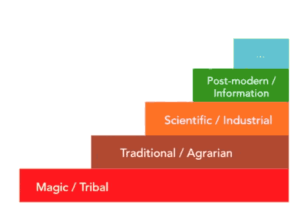
History shows that humankind made big leaps in development. Science agrees on these stages: magic/tribal, agrarian/traditional, scientific/industrial, post-modern/information and then we get to our current era. Will we call this the authentic age, integral age?
We changed thinking and technology in each phase. We invented a new management paradigm in each stage. This will be the fifth time that we do a major step-up.
Red organizations look like one tribe with a chief, they gather, and fight the other tribes – and try to dominate. 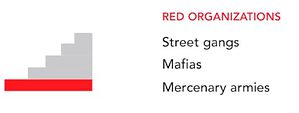 They are crude and make slaves. You’ll find some remains today as street gangs: they are small, unstable, informal, fear-based. The boss has to constantly inspire fear to stay the boss, just like wolf packs. This was the normal way of collaborating and being in the magic/tribal age.
They are crude and make slaves. You’ll find some remains today as street gangs: they are small, unstable, informal, fear-based. The boss has to constantly inspire fear to stay the boss, just like wolf packs. This was the normal way of collaborating and being in the magic/tribal age.
Then we created the agrarian revolution, 5000 years ago, and we evolved toward amber organizations.  They have rules; they are structured with one boss, one God, and laws. They are hierarchical and stable. Examples are the Catholic church organization, armies, public schools. They invented two breakthroughs:
They have rules; they are structured with one boss, one God, and laws. They are hierarchical and stable. Examples are the Catholic church organization, armies, public schools. They invented two breakthroughs:
1. formal hierarchy (the pope doesn’t have to scare all the priests around the world to stay the Pope)
2. replicable processes (the harvest is planned – sowing is organized, etc.).
With their levels and reliability, they created cathedrals, irrigation systems – that were unthinkable before…! Their metaphor is: organizations as armies.
The scientific revolution led to orange organizations.  This time, people started to think instead to trust authority blindly. They understood they could make a profit if they were faster, and innovated, and used their thinking. Here’s the model and mindset of multinationals, Wall Street, consultancy firms. The key breakthroughs were:
This time, people started to think instead to trust authority blindly. They understood they could make a profit if they were faster, and innovated, and used their thinking. Here’s the model and mindset of multinationals, Wall Street, consultancy firms. The key breakthroughs were:
1. innovation (where our prosperity comes from; R&D)
2. accountability (instead of the boss telling what and how to do – now you’re accountable)
3. meritocracy (In Amber, the priest would never become pope, but now the intelligent ones have a chance, liberation for individuals)
The metaphor: organizations as machines.
Our post-modern information age gave birth to more and more green organizations.
People aren’t just productivity factors – soft skills become important in service and collaboration. Culture becomes important – see how Starbucks, Southwest Airlines, Zappos, Ben&Jerry’s consciously built theirs. The assumption: if people are happy and passionate – we’ll be okay as an organization. Their breakthroughs are:
1. value-driven culture
2. empowerment
3. stakeholder model, instead of shareholders alone
This is still ongoing. Green organizations outperform the former stage organizations. Their metaphor is: we are a family.
So, the organizational stages of human development were: wolf packs, armies, machines, families. What’s next? That’s what I wanted to find out.
My research entailed 20-30 successful, different organizations and I ended with 12 that I studied up close.
What struck me is how similar they operate. They are: Heiligenfeld, FAVI, AES, Morning Star, ESBZ, BSO/Origin, Sounds True, Buurtzorg, Sun Hydraulics, RHD, Patagonia, Holacracy. They are extraordinary but not well known. They operate in different industries and different places, some global. They are so different, and yet, they are doing some new things the same way – this evolved without knowing of the others.
The Story of Buurtzorg
Let’s look at the story of Buurtzorg – healthcare in the Netherlands. It’s neighborhood nursing – they work in people’s homes.
The Netherlands had these autonomous nurses for ages, until the 1980s when the state pushed nurses to join organizations for economies of scale. Now, nurses could take a day off. But orange logic took over: organizations decided to specialize nurses; the expensive nurses do difficult stuff, beginners do simple intakes. They centralized with a call center, with standard times, and norms to apply compression stocking in 5 minutes etc. Nurses received a planning – go here at 8 am and you have 10 minutes. These health care organizations started to merge to get more scale economies and power; nurses got supervisors, managers, and levels.
Clients hated the system. They used to have one trusted nurse. Now, they had new nurses all the time who were in a hurry. The nurses hated it – they’d been turned into a machine, they had less contact with clients.
Jos de Block used to be a nurse and created Buurtzorg in 2007. He gathered ten nurses – to have enough economies of scale and let’s self-organize…! Buurtzorg consists of 8000 people in 2014, their market share is 80%
If you have 10-12 people you can start a cell and Buurtzorg will teach you how to do this.
Headquarters counts 25 people – they teach nurses how to operate without a boss: How to do meetings, make decisions, handle conflict? They work with 1-2 nurses per client, there’s time for bonding, contact, and for coffee.
Buurtzorg’s purpose is not just providing medical care, but to help people live meaningful lives. A financial study showed that Buurtzorg uses only 40% of care hours prescribed by doctors, so they save money for the Dutch state that finances the health care system with public money. Buurtzorg also makes patients autonomous because they help them to organize other support and resources. Buurtzorg is a “new organization”.
Breakthroughs of new organizations
These new organizations created three breakthroughs. First is self-management. 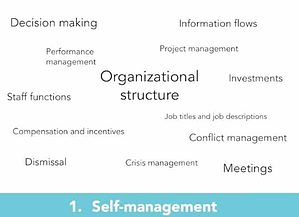 Working without a boss in large organizations sounds like a recipe for chaos. Well, you need structure, but you don’t need a boss. We need to upgrade our thinking. Hierarchy is fine in environments with low complexity: use the pyramid. But in case of high complexity – hierarchy fails because it pushes information and complexity to the top – you can’t handle that.
Working without a boss in large organizations sounds like a recipe for chaos. Well, you need structure, but you don’t need a boss. We need to upgrade our thinking. Hierarchy is fine in environments with low complexity: use the pyramid. But in case of high complexity – hierarchy fails because it pushes information and complexity to the top – you can’t handle that.
Complex systems operate differently. An example is the global economy: it doesn’t have a boss but it functions nevertheless. Or think about the human cell, it is highly complex but has no boss. The human brain consists of millions of cells, but there is no CEO. There is structure and coordinating mechanisms. A forest is a complex eco system – with billions of micro organisms, animals, trees, but not one tree is the CEO.
As the world is becoming more complex, we’ll have to shift the way we run organizations.
Our current paradigms cannot cope with the complexity. But these new organizations have cracked the code. You need structure, or you’ll have chaos – so they reinvented structure and processes.
Who may decide?
Example: should decision making be hierarchical or consensus? That’s how we think – in dichotomies. It’s either the boss or long, exhausting talking where everyone gets frustrated. In many organizations we do a bit of both – consult people – then the boss or a small team decides for everyone. But there is a third way: the advice process – the best of both worlds. Any person can make any decision, including spending money – but they must have sought advice from those with expertise and those who will be impacted by the decision.
If I buy a new machine as an operator in the factory, I need to talk to finance, an engineer, and my colleagues. I don’t need approval, or watered-down consensus. Instead, I utilize a process of collective intelligence – but it’s my individual decision. This liberates energy – because we can take this space and decide!
Everyone can decide and can advice – so people take this seriously: you can be on either side. This is intersubjectivity. Interesting is the decision; who gets fired? According to the rules, that’s the one who dismisses this advice process.
Who makes how much money? Another interesting decision in new organizations.
Morning Star was founded in the 1970s by Chris Rufer, who transported tomatoes across the US. Now, they have a 70% marketshare in the US and they produce 50% of North-American tomato paste. Their factories go without a boss.
Once a year everyone writes a letter: “I grant myself a raise of 2% with all the reasons why”. Every plant has a committee that gives advice: they compare all the letters of their colleagues – and give feedback: too much or too little. But everyone is free to decide what they want. But information is public – so if I keep my 7% raise against the advice – then I’d better proof that I’m worth it! Morning Star has proved that people are good estimators of salary – only 1% takes too much. In a way, self-management forces everyone to grow up.
If you don’t like your salary, raise it – and earn it…. Complaining falls away. There are no hierarchical relationships; so there’s no need “to nag your parents for more candy”.
Wholeness
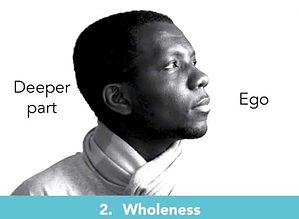 The second breakthrough of new organizations is Wholeness. There’s an expectation we show up at work with a professional self – which pushes us to wear a mask. Some will deny this, but for most people it is a mask that we’re used to. Showing up with ego is accepted in organizations. But is not all of who we are, it’s not our whole self.
The second breakthrough of new organizations is Wholeness. There’s an expectation we show up at work with a professional self – which pushes us to wear a mask. Some will deny this, but for most people it is a mask that we’re used to. Showing up with ego is accepted in organizations. But is not all of who we are, it’s not our whole self.
Sharing deeper hopes and needs, doubts or second thoughts can be very risky. Imagine you work in an advertising agency and say: I want to talk about how we create needs so people buy stuff that ultimately pollutes the world and makes those who can’t afford it unhappy…. What if a doctor wondered out loud: We’ve reduced this hospital to a factory, how can we take care of emotional and spiritual healing? We learned that it is not wise to express these deeper thoughts.
Compare it to masculine and feminine attitudes and behaviors. The masculine is appreciated; it means resolve, determination, being clear, looking forward and not backwards. The feminine entails: questioning, vulnerability, caring, nurturing. At work, we show up in our masculine outfit.
We also have an emotional, intuitive, rational and spiritual side. The rational is appreciated in the workplace, but we are supposed to leave emotions, intuitions and spiritual considerations at home.
So, we end up showing this very narrow rational masculine ego side of ourselves only. That’s 1/16th part of our whole selves, if these rational images resemble reality. When that is the case, we show up with 1/16th of our energy and passion.
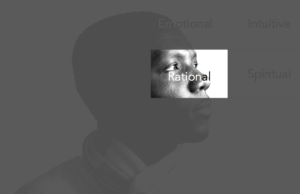
While in those new organizations I’ve researched – we show up with our whole selves. They brim with energy and authenticity. To be whole at work, they have reinvented things like: safe space, meetings, storytelling, working hours, on-boarding, feedback, and evaluations. They’ve created a safe space – or we won’t show up fully because we’re vulnerable. New organizations use practices to make it safe, and to invite us to be truly human.
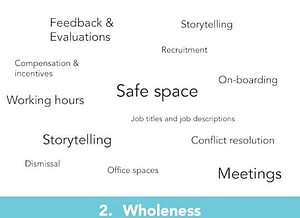
Let’s look at Heiligenfeld, a German network of mental healthcare hospitals. They take
spiritual healing into account, in addition to medicating patients. They’ve created a process for meetings with cymbals. What to with cymbals? The goal is: whenever they feel someone is speaking from his ego, fighting for his own group or career, or wants to win a debate – they sound the cymbal. Then, there’s silence for a minute – to answer the inner question: Who am I trying to serve? In public, egos tend to come out, that’s what the context of meetings does. The cymbals help them stay whole. Nowadays, they rarely have to use the cymbals anymore. They get it. Everyone also did a training in active listening and non-violent communication.
Another deliberate practice to enhance wholeness is from a public high school in Berlin. They are self-managing, both kids and teachers. But here’s a challenge: how can you invite adolescents to be themselves? This is the age when you wear masks – and your image counts!
They gather every Friday for 45 minutes and start with 5 minutes of singing. They have an open microphone: everyone can say something. You can thank someone or make a compliment. People tell mini-stories when they thank someone and they reveal something about themselves as well. Here we see adolescents who dare to be authentic in front of 500 people! There are no violence problems, the pupils are passionate to learn and they are accepted.
Evolutionary Purpose
The third breakthrough is Evolutionary Purpose. All organizations say they have a purpose, but the real priority is money. Organizations put their competitive advantage in a vault. Jos de Block however, Buurtzorg’s CEO sent his book to their competitors. He explains how Buurtzorg works and how their purpose is to help people live meaningful, autonomous lives. De Block’s goal is not his organization, but his purpose. He does active consulting for competitors and doesn’t send a bill – because he’s serious about his purpose.
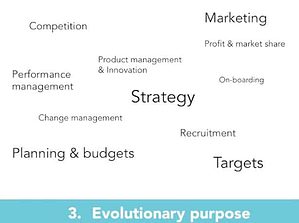
In the traditional organization, the role of leaders is to create vision and strategy and how to get there: they lead the execution. The organization is an inanimate object – leaders program it. The new guys believe that organizations are living beings. The organization itself has a sense of direction that it wants to manifest. In new organizations, our role as leaders is to listen to where the organization wants to go naturally – an to align people and processes.
The practices they do differently are: strategy, planning and budgets, marketing etc. None of the new organizations has a strategy. They have a clear intent, a direction, and respond to what happens while they travel in that direction. They don’t have budgets and targets – because milestones are a distraction from reality. Milestones make you look at your plan instead of what happens in front of you. It’s better to listen to reality and constantly adjust.
An example: Buurtzorg Plus. You know that old people break bones easily, they seem to fall often. So Buurtzorg decided to focus on prevention. In each region, a physiotherapist taught people how to walk, move around the house in a safe way. They changed things in their homes. The nurses organized this, it was not official strategy to go into the prevention business. A traditional leader says yes or no, provides a budget and rolls out a plan. Jos de Block said: Let’s see what happens with this energy. Let’s share it with the other Buurtzorg teams. Give them the package of how to do it – so they don’t reinvent the wheel. Other teams started to do it, too. But some didn’t feel like it, and that was okay. There’s no obligation – people follow their energy.
Another team is starting a partner program: old people who need care have old partners, and giving care is heavy on them. They founded a boarding house where they take in the sick so their partners can relax for a few days. The idea evolved and is presented on the Buurtzorg big gathering of 8000 staff. Anyone who wants to organize this in their team, is welcome to do so.
This is how new organizations are creating the future, by stepping into and sensing the field. The purpose is central and creates the field. Then, we sense what wants to emerge.
They don’t play God, but listen to what wants to happen – and then go with that flow.
How do you create such a new organization? Read the book Reinventing Organizations!
* In what kind of organization are you working? Red, amber, orange, green or a new organization?
* Which of the “new” practices can you implement at work?
* How can Buurtzorg, Heiligenberg, Morning Star of the public high school inspire your workplace?
* How do you feel about self-management? Where can you let go to enhance it?
* How can you become whole at work and inspire others to do the same?
* How can you find your purpose and practice it? How can you facilitate the purpose of your team and organization?
* What will you do (differently) next week, after having read this article?
Frederic Laloux is a management consultant, thought leader, author, and speaker. You can download the book Reinventing Organizations and pay what feels right.
Do you like this post? Please help me spread positivity by tweeting, sharing, and liking.